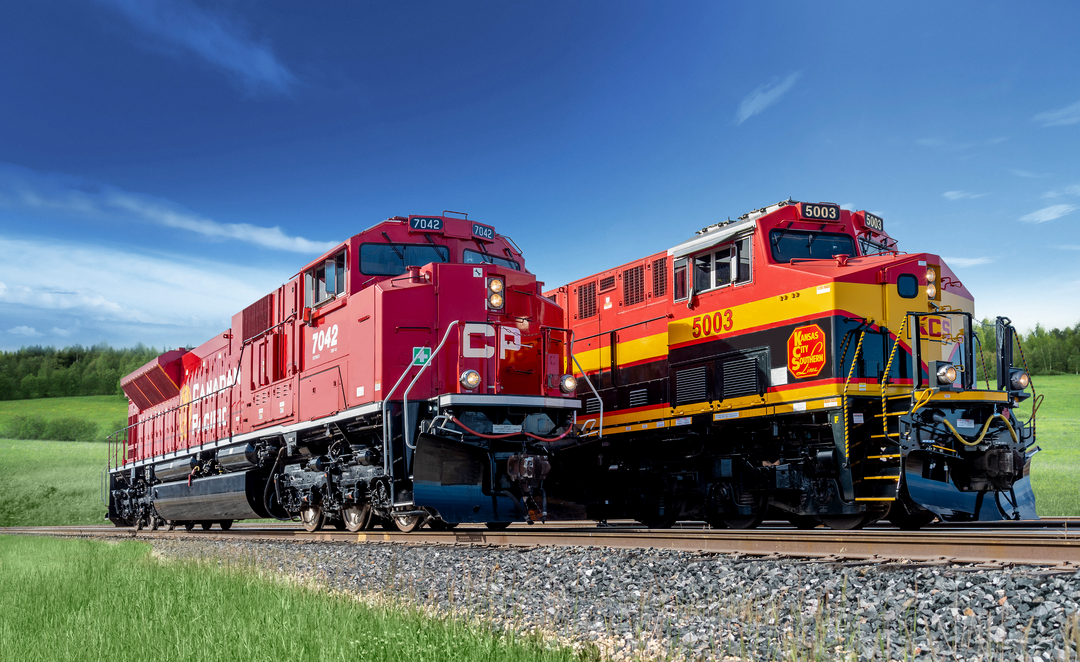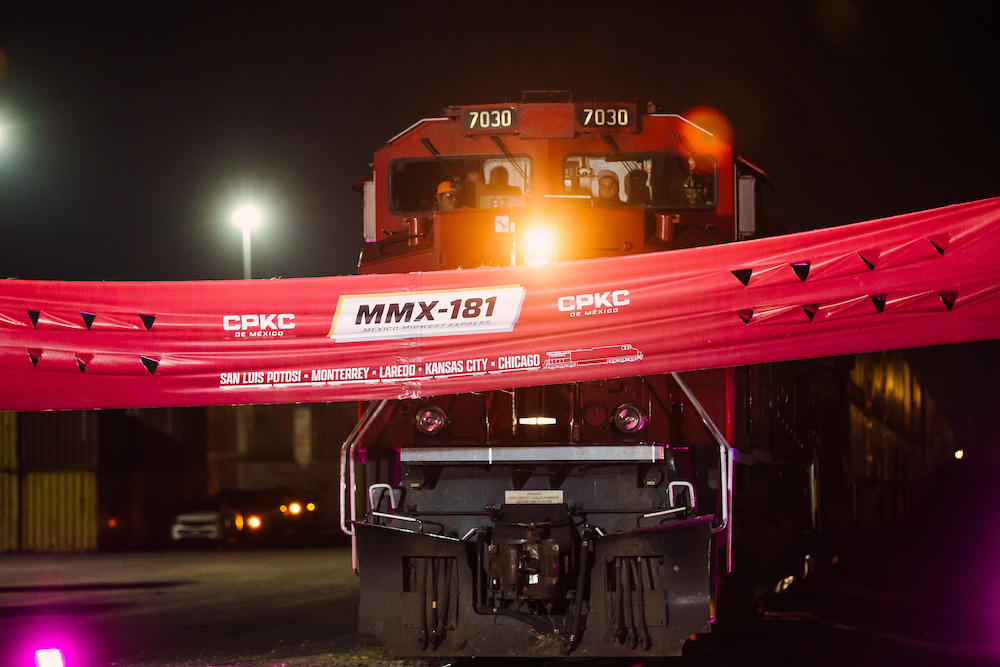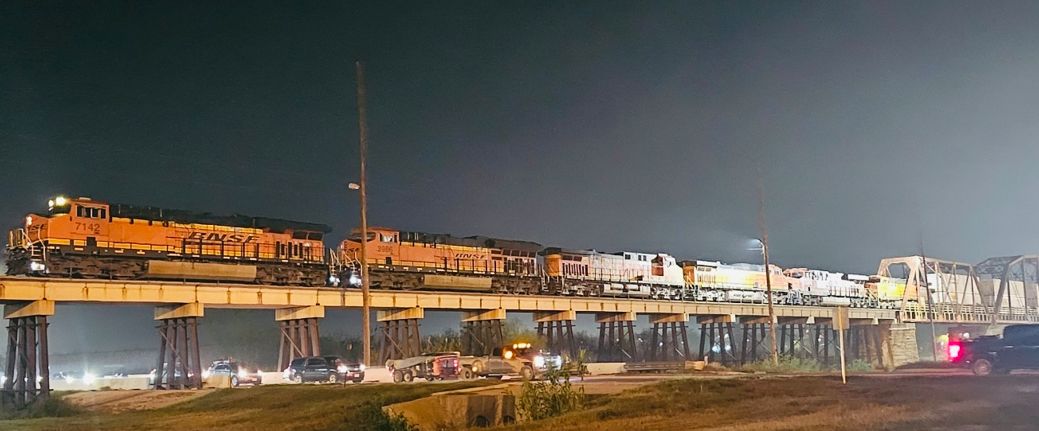
Last year’s merger of Canadian Pacific and Kansas City Southern, the two smallest Class I systems, has turned out to be the little spark that has ignited a lot of railroad competition.
Skeptics have scoffed at Canadian Pacific Kansas City’s meandering route from the Midwest to the Mexican border at Laredo, Texas. It’s got more grades, more curves, more miles, and lower speed limits than the rival main lines of Union Pacific and BNSF Railway.
Plus, CPKC doesn’t control its own destiny. It relies on trackage rights over UP between Beaumont and Rosenberg, Texas, on the western outskirts of oft-congested Houston, and then again between Victoria and Robstown, Texas.
All this has prompted some observers to wisecrack that CPKC’s route is the fourth best out of the three that connect Chicago and Mexico. Yet it seems that the other railroads are taking the underdog CPKC and its unique single-line service quite seriously.

Just look at their responses to CPKC’s Mexico Midwest Express premium intermodal service, which was launched in May and links Chicago and Mexico with trucklike reliability and transit times.
Canadian National, Union Pacific, and Ferromex teamed up for Falcon Premium intermodal service. The cross-border trains — launched the week after CPKC’s MMX — connect CN’s terminals in Canada and Detroit with points in Mexico via Ferromex. New UP CEO Jim Vena subsequently tightened the trains’ schedules by a day when he arrived in Omaha in August.

BNSF Railway and partner J.B. Hunt in December shifted their cross-border intermodal business away from CPKC’s Laredo gateway in favor of a Ferromex routing via Eagle Pass, Texas. The new route is 24 hours faster.
In a move that will create a new interchange and interline service between the Southeast and Mexico, CPKC and CSX in May announced that they will acquire and operate Genesee & Wyoming short line Meridian & Bigbee. The short line fills the 168-mile gap between CPKC at Meridian, Miss., and CSX at Montgomery, Ala.
Union Pacific responded to this development by announcing new interline intermodal service linking points in Mexico with CSX, Norfolk Southern, and Florida East Coast terminals in the Southeast via Memphis. The service relies on rubber-tiring boxes between Memphis terminals, however, which is not ideal. But it does give UP’s intermodal customers a head start against the eventual CPKC-CSX service.
Other railroads have responded elsewhere, too.
CN and NS in September announced new interline service connecting CN’s terminals in Canada with NS terminals in Kansas City and Atlanta via steelwheel interchange at Detroit and Chicago. CN had unsuccessfully sought access to Kansas City as part of its failed attempt to acquire KCS, and then later during the CP-KCS merger review.
Also in September: CN began intermodal service linking Mexico with the Midwest and Canada in a partnership with Crowley, whose container ships sail weekly between the Port of Mobile, Ala., and Tuxpan, Mexico.
One rail executive says Class I railroads have hatched more interline deals in the past 10 months than they did in the past 10 years. The common thread among all these new joint services? They could have been created years ago. But railroads instead chose to sit on their duffs.

CPKC CEO Keith Creel chalks this up to human nature. “When you’re not challenged — and this is human nature, this is railroading nature, this is any business nature, this is competitive sport nature, this is just a fact of life — sometimes complacency can set in,” Creel told the RailTrends conference in November. “And this industry is in a place where we needed to be better. We need to be better for all stakeholders, not just our own, but for this nation.”
Creel’s analysis is spot-on. But there are two other reasons behind the recent uptick in interline deals.
First, CSX, NS, and UP all looked inward from 2017 through 2020 as they pruned interline service while adopting Precision Scheduled Railroading. The focus was on cutting, not adding, although there were exceptions, such as CSX-CN joint intermodal service linking the ports of New York, New Jersey, and Philadelphia with Toronto and Montreal.
Second, railroad service has largely recovered from the widespread crew shortages that snarled traffic in 2022 and the first half of 2023. No railroad in its right mind would begin new service when it couldn’t deliver.
CPKC has shaken up the industry. Let’s hope complacency is out – and more cooperation and competition are in.
You can reach Bill Stephens at bybillstephens@gmail.com and follow him on LinkedIn and X @bybillstephens














The history of railroading is full of the inferior railroad in terms of geography and traffic base being able to outshine better positioned competitors through excellent management and superior service. This has been obvious in the management of both CP and KCS separately, and CPKC together.
CPKC is my hometown railroad (Waukesha County Wisconsin) and I’ve always been a fan of its northern half. I want it (or any corporation, for that matter) to succeed. That it’s still in business eight or nine months in, is a good omen, a good start.
CPKC in America is a gerrymander of single-track lines, whatever was left over after all the other mergers, and/or crucial trackage rights. By being (LITERALLY) and end-to-end merger, there are (LITERALLY) no duplicate or parallel lines or facilities to rationalize.
Living alongside one of the few double-iron lines (Chicago to Milwaukee to Pewaukee) makes for good train watching. My question is though, this: tell me again how CKPC gets a train from Toronto to KCMO? If that isn’t a main corridor for the railroad, nothing is.
Charles: Toronto to KC. I don’t know if CPKC is doing it or exploring the possibilities of running solid blocks or even through trains. But here’s my route: 1) Toronto-Windsor on their own rails, 2) Windsor/Detroit-Butler, IN to either the IHB at East Chicago, IN (CP503) or the BRC at South Chicago, IL (Rock Island Jct/CP509) on NS trackage rights, 3) BRC Rock Island Jct-Metra Milw West (CPKC Elgin Sub)/Cicero West Int./Metra B12 Int at FranklinPark/east end Bensenville Yard, 4) IHB at CP503-Metra B12 Int at Franklin Park/east end Bensenville Yard. West of Bensenville Yard is obvious.
MARK — I thought CP Rail (not NS) owns the former Michigan Central Detroit – Windsor tunnel …. not that it matters, the route you state is the exact same one way or the other. Historically, the tunnel served to connect Chicago – Detroit either to Toronto (CP Rail), or to Buffalo – New York – Boston (New York Central). The latter route via St. Thomas (Ontario) is long gone but survived into the Amtrak era as the route of the Niagara Rainbow.
The Niagara Rainbow was interesting in that under 403(b), the states of Michigan and New York paid for an extension of an Empire Service train from Buffalo to Detroit —- a route that was almost entirely in Canada. The train was discontinued when New York State pulled out; after that the tracks soon were torn up. In any event, New York Central in its heyday could detour a Chicago – New York train, if necessary, through Michigan and Ontario.
I rode the Niagara Rainbow in 1975. Maybe the least scenic route in the Amtrak timetable, but that’s just from knowing the territory, not from seeing it from the train. This is said to be the flattest land anywhere on earth. We literally couldn’t see out the window, this being Amtrak’s “Lexan” era. If I recall the coach was ex-New York Central.
As we know the tunnel forced the 1913 relocation of trains from downtown Detroit, west to the giant Michigan Central Station in Corktown — the building now owned by Ford Motor Company.
What this proves is that interline agreements are possible to effectively counteract CPKC’s supposed advantage with “single line” service.
The question now becomes: What (if anything) can CPKC similarly to do effectively counteract its single-line route that is (north of the border) dramatically inferior to the competition in mileage, profile, capacity, running times, terminal delay, and origin/destination locations?
And Mr. Stephens: Is “CPKC’s Mexico Midwest Express premium intermodal service, which was launched in May and links Chicago and Mexico with trucklike reliability and transit times” indeed completely competitive with trucks, or are you (again) parroting a CPKC press release? What source is available to determine past on time delivery status of train and truck? The fastest truck route doesn’t include traversing Northeast Iowa, Kansas City, or Louisiana as is the case with CPKC’s circuitous route. Truck companies advertise 2 or 3 day service from Chicago to Laredo, whereas CPKC advertises “third day service” from Chicago to Laredo.
The one-year anniversary of the CPKC merger is a scant three months away. A full report of what difference it has, or has not, made would make for very interesting reading.
Hi Mark,
Schneider execs have praised the MMX service. They say the combination of reliability and single-line service will lead to significant growth in cross-border intermodal.
CPKC CEO Keith Creel said this at the MARS conference earlier this month: “That train is running truck-like reliable — 94%, 95%. I look at it every day. It’s running like clockwork. We said it was going to get there in 98 hours. We are consistently, reliably getting it there 94, 92, 93, 94, both ways. Reliable service to grow with our customers, to create a backbone for new supply chains to take trucks off the road for the environmental benefits. So again, we’re doing what we said we would do. We’re extremely pleased with and look forward to continue to grow with partners on that train.”
Also, CPKC de Mexico has a mileage advantage over Ferromex from the border to Monterrey and SLP.
Thanks for reading and taking the time to comment.
Bill
“One rail executive says Class I railroads have hatched more interline deals in the past 10 months than they did in the past 10 years.” Back in the ICC days railroad “A” shortened transit times between two points prompting competing railroad “B” to complain, “We will have to invest in our plant to match your schedule with no increase mileage revenue. HOW COULD YOU DO THAT TO US?” Granted, the best thing a railroad can do is the exact same thing every day, day after day. But said staid circumstances defy the reality of the marketplace. That it took the two smallest Class 1s to merge and become the newest, smallest Class 1 shows how long these deals have been moldering on the table. Pathetic.